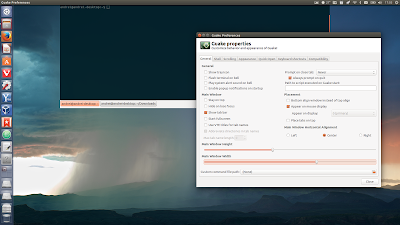Guake 0.8.7
Guake is a drop-down terminal emulator for GNOME (GTK2). The application is inspired from consoles in computer games, such as Quake, in which the console slides from the top of the screen when a key is pressed. In the same way, Guake can be invoked and hidden using a single key (though Guake can also automatically hide when it loses focus).
Guake 0.8.6 (followed by 0.8.7 as a minor bugfix release) was released recently with various changes:
- added option to shorten VTE tab names (Guake Preferences > General > Abbreviate directories in tab names)
- terminal geometry fixes; in my test (under Ubuntu 16.04), issues such as Guake not being aligned correctly on multi-monitor setups (running Unity) no longer occured;
- fix the bottom of tab buttons being cut off in GNOME;
- fix Guake window follow mouse option not working in fullscreen;
- fix "changing max tab length" set all tab to same title;
- fix Guake creating zombie processes in GNOME 3.18.
Ubuntu / Linux Mint users can install Guake by using the WebUpd8 Unstable / Backports PPA (see all the packages available in the PPA HERE). To add the PPA and install Guake, use the following commands:
sudo add-apt-repository ppa:webupd8team/unstable
sudo apt update
sudo apt install guakeTo download the Guake source, report bugs, etc., see its GitHub page.
WebTorrent Desktop 0.12.0
WebTorrent Desktop is an open source BitTorrent client that can stream torrents, available for Linux, Windows and Mac. The application can stream either locally, or to AirPlay, Chromecast, and DLNA.
WebTorrent 0.11.0 was released about 4 days ago, followed by version 0.12.0 today. Among the changes implemented with these releases are:
- support external applications for streaming torrents; this can be set in the WebTorrent Preferences, and requires "Play in External Player" option to be enabled;
- new Preference to "Set WebTorrent as default handler for torrents and magnet links". Previously, the app made itself the default torrent file handler automatically. This option does not seem to work on Linux (or at least, it didn't work in my test);
- Linux: add system-wide launcher and icons for Debian (and Ubuntu). Previously, you had to run the application once to get the menu entry to show up;
- bug fixes.
A complete changelog can be found HERE.
Download WebTorrent Desktop
TLP 0.9
TLP is an advanced power management tool for Linux. The command line tool tries to optimize battery life by appliying various settings and tweaks, depending on your Linux distribution and hardware. While TLP is designed to work out of the box, without any user input, you can change various settings by editing its configuration file (/etc/default/tlp).
Changes in TLP 0.9 include:
- tlp-stat now distinguishes between:
- state: TLP enabled or disabled via configuration file;
- last run: last time when TLP was invoked;
- mode: selected power mode on last invocation;
- power source: actual power source.
- tlp-stat now displays battery charge and capacity (last full charge) values in percentages;
- disks: AHCI runtime power management for host controllers and attached disks;
- add another ThinkPad OneLink Pro Dock USB LAN (17ef:304) to Radio Device Wizard (tlp-rdw);
- ThinkPad battery functions now load tp-smapi or acpi-call kernel modules on compatible models only
- Radio Device Wizard now properly handles removal of USB Ethernet adapters (e.g. as contained in several USB docks)
- more.
A complete changelog can be found HERE.
I should also mention that on my laptop, the wired network no longer works (on AC only) when resuming from suspend, if TLP is installed. I was able to fix this by setting "WOL_DISABLE=N" in the TLP configuration file (/etc/default/tlp), and then restarting the system. This could be related to my hardware / setup though, so it might not occur for you. Issue reported HERE.
To install the latest TLP in Ubuntu, Linux Mint, and derivatives, you can use its official PPA. Add the PPA and install it using the following commands:
sudo add-apt-repository ppa:linrunner/tlp
sudo apt-get update
sudo apt-get install tlp tlp-rdwFor other Linux distributions, see the TLP installation instructions.
To download the source, report bugs, etc., see the TLP GitHub page.



